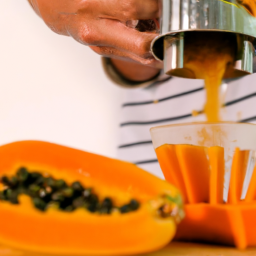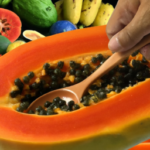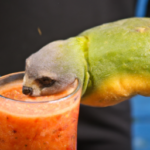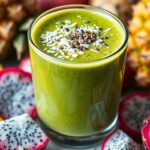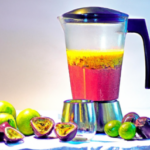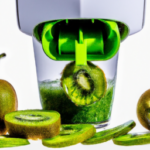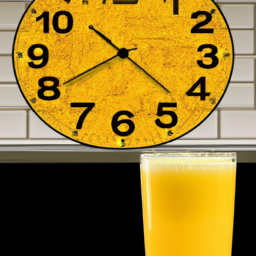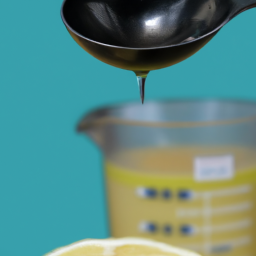When it comes to juicing, there are countless fruits and vegetables to choose from. But have you considered incorporating papaya into your blend? Papaya is not only delicious and packed with nutrients, but it also enhances any juicing routine.
In this article, I will guide you through the steps to juice a papaya, from selecting the perfect fruit to cleaning up your juicer.
First, it’s important to understand why papayas are such a great fruit to juice. Papayas are packed with vitamins and minerals, including vitamin C, folate, and potassium. They also contain enzymes that aid in digestion and help reduce inflammation. Plus, they have a unique flavor that pairs well with other fruits and vegetables in a juice blend.
So, if you’re ready to add some tropical flair to your juicing routine, let’s get started on juicing a papaya!
Key Takeaways
- Choose a ripe papaya with yellowish-orange skin and a few green patches.
- Use a juicer with a blade designed for soft fruits and vegetables and adjust the speed to a lower setting to avoid over-pulverizing the fruit.
- Complementary ingredients include ginger, turmeric, mint, basil, pineapple, mango, apple, and citrus fruits, and experimenting with different flavor combinations is encouraged.
- Store papaya juice in an airtight container in the fridge for up to 24 hours, use time-saving techniques for cleaning up, and consult with a healthcare professional before adding papaya juice to your diet.
Selecting the Perfect Papaya
Don’t settle for any papaya, you gotta pick the one that’s just right for juicing!
When selecting a papaya, there are a few things to keep in mind. First and foremost, consider the ripeness of the fruit. Papayas should be ripe but not too soft. Look for papayas that are slightly soft to the touch and have a yellowish-orange skin with a few green patches. If the fruit is too green, it will be too hard and not sweet enough for juicing. On the other hand, if the papaya is too ripe, it will be too mushy and not have a good flavor profile.
Once you have found the perfect papaya, it’s time to prepare your juicer. Cut the papaya in half and scoop out the seeds with a spoon. Next, cut the fruit into small chunks that will fit into your juicer chute. Remember to peel the skin off of the papaya before juicing.
Now that you have selected the perfect papaya and prepared your juicer, it’s time to start juicing!
Preparing Your Juicer
Before you start juicing, it’s essential to prepare your juicer properly. This involves cleaning and assembling it correctly, so it’s ready to use.
I’ve found that choosing the right settings for your juicer is also crucial to achieve the desired results.
Cleaning and Assembling Your Juicer
First, you’ll want to make sure you have all the necessary parts for your juicer, like the strainer and juice container, before getting started. This will help you avoid any unnecessary interruptions during the juicing process.
Once you’ve collected all the parts, you’ll need to clean them thoroughly before assembling the juicer. Cleaning is crucial for maintaining the efficiency of your juicer, so be sure to follow the manufacturer’s recommended maintenance tips.
After cleaning the parts, it’s time to assemble the juicer. This is a crucial step for ensuring that the machine operates smoothly and efficiently. Be sure to follow the instructions in the user manual carefully, and pay close attention to the order in which the parts are assembled.
Once your juicer is assembled, you can move on to choosing the right settings for juicing your papaya.
Choosing the Right Settings
Now it’s time to figure out which settings are best for you to get the most out of your juicer and enjoy all the delicious benefits of fresh fruits and vegetables.
One of the key factors in choosing the right settings for your papaya juice is adjusting the speed of your juicer. Most juicers come with different speed options, and higher speeds are usually best for harder fruits and vegetables, while lower speeds work better for softer ones. As papayas are relatively soft, you’ll want to choose a lower speed setting to avoid over-pulverizing the fruit and losing some of its nutrients.
Another important factor to consider when juicing papayas is the blade size of your juicer. Some juicers come with different blade sizes that can be adjusted depending on the type of produce you’re juicing. For papayas, you’ll want to use a blade that’s specifically designed for soft fruits and vegetables. This will help you get the most juice out of your papaya while minimizing waste and ensuring that your juice is smooth and easy to drink.
With your speed and blade settings in mind, you’re now ready to move on to the next step: preparing your papaya for juicing.
Preparing Your Papaya
Get your papaya ready by washing it thoroughly under running water, just like you’d wash your hands before a meal.
Papaya ripeness is important when it comes to juicing. A ripe papaya will give you a sweeter juice, while an unripe one will be more bitter. To determine the ripeness of your papaya, gently press the skin. If it gives slightly, then it’s ready to be used. If it’s still hard, leave it out at room temperature until it ripens.
Cutting techniques are also important when preparing your papaya. To start, cut off the top and bottom of the papaya with a sharp knife. Then, cut the papaya in half lengthwise. Use a spoon to scoop out the seeds and discard them. Finally, cut the papaya into smaller pieces that will fit into your juicer.
Wash your papaya thoroughly under running water.
Choose a ripe papaya for a sweeter juice.
Use the proper cutting techniques to remove the seeds and cut the papaya into smaller pieces.
Discard the seeds.
Benefits of drinking papaya juice include improved digestion, lower inflammation, and a boost of antioxidants.
Now that your papaya is prepped and ready, it’s time to move on to choosing complementary ingredients for your juice.
Choosing Complementary Ingredients
Make your taste buds dance with a combination of complementary flavors that’ll elevate your papaya juice to a whole new level.
When choosing complementary ingredients, consider the flavor combinations and nutritional benefits. For example, adding ginger or turmeric won’t only give your juice a spicy kick but’ll also provide anti-inflammatory benefits.
Mint or basil will add a refreshing taste and aroma, while also providing antioxidants and vitamins.
Other complementary ingredients that work well with papaya include pineapple, mango, apple, and citrus fruits such as oranges or lemons. These fruits’ll add a sweet and tangy taste, and also provide a boost of vitamin C and other essential nutrients.
Don’t be afraid to experiment with different flavor combinations and find your personal favorite. With the right ingredients, your papaya juice can be transformed into a delicious and nutritious drink that’ll leave you feeling refreshed and energized.
Now, let’s move on to creating your juice blend.
Creating Your Juice Blend
Imagine a symphony of flavors dancing on your taste buds as you blend together a perfect combination of fruits and spices to create a refreshing and revitalizing drink. Experimenting with flavors is key to creating a unique and delicious juice blend. Consider the nutritional benefits of each ingredient when selecting complementary fruits and vegetables.
Here are three tips to get you started:
-
Start with a base of papaya. Papayas are a great source of vitamins A and C, as well as potassium and fiber. They also have a sweet and slightly musky flavor that pairs well with many other fruits.
-
Add some citrus. Lemons, limes, and oranges are all great choices to add a bright, tangy flavor to your juice. Citrus fruits are high in vitamin C and antioxidants, which can help boost your immune system.
-
Experiment with herbs and spices. Fresh mint, ginger, and cinnamon can add depth and complexity to your juice blend. These ingredients also have their own unique health benefits, such as aiding digestion and reducing inflammation.
As you create your juice blend, keep in mind that you can always adjust the amounts of each ingredient to suit your personal taste preferences.
Next, we’ll explore adding sweeteners to your juice blend.
Adding Sweeteners
Now you may be wondering how to add a touch of sweetness to your juice blend without relying on sugar or artificial sweeteners. Luckily, there are plenty of alternative sweeteners and natural options that can be used to sweeten up your papaya juice.
One popular choice is honey, which is a natural sweetener that has antibacterial and anti-inflammatory properties. It can also help boost your immune system and soothe a sore throat.
Another option is maple syrup, which is a natural sweetener that is rich in antioxidants and minerals like zinc and manganese. It has a unique flavor that can add depth to your juice blend.
Other natural sweeteners include agave nectar, stevia, and dates. These options are healthier than traditional sugar and can help you avoid the negative health effects associated with consuming too much added sugar.
As you finish sweetening up your papaya juice, it’s important to think about how to store it properly. One way to do this is to store it in an airtight container in the fridge for up to 24 hours. This will help preserve its freshness and keep it from spoiling.
By taking these steps, you’ll be able to enjoy your delicious and nutritious papaya juice for longer periods of time.
Storing Your Juice
To keep your freshly prepared papaya juice from going bad, it’s important to store it properly. The best way to store your papaya juice is by keeping it in an airtight container and placing it in the refrigerator for up to 24 hours. This will help to preserve the nutrients and flavor of the juice.
There are also other preservation techniques that can be used to store your papaya juice for longer periods of time, such as freezing it in ice cube trays or using a vacuum sealer. However, it’s important to note that the longer the juice is stored, the more nutrients it will lose. So, it’s recommended to consume the juice as soon as possible to get the maximum health benefits.
With proper juice storage, you can enjoy a refreshing and healthy drink anytime you want.
Now that you know how to store your papaya juice, it’s time to move onto the next step: cleaning up.
Cleaning Up
Get ready to clean up by gathering all the necessary tools and materials. Effective methods for cleaning up after juicing a papaya include using a strainer to separate the pulp and seeds from the juice, rinsing the juicer thoroughly with warm water and soap, and wiping down all surfaces with a damp cloth.
Time-saving techniques include lining the pulp container with a plastic bag for easy disposal, preparing a sink filled with warm soapy water before juicing, and cleaning up as soon as possible to prevent pulp and juice from drying and becoming difficult to remove. With these methods, cleaning up after juicing a papaya can be quick and hassle-free, leaving you with more time to enjoy your delicious and nutritious juice.
As you finish cleaning up, keep in mind some tips and tricks for juicing papayas. For example, you can add other fruits or vegetables to the mix for added flavor and nutrition, or experiment with different juicing techniques to find the perfect balance of pulp and juice.
Tips and Tricks
One interesting tip for juicing is to mix in other fruits or vegetables to enhance the flavor and nutritional value, such as adding kale or ginger to your juice. Not only does this provide a boost of vitamins and minerals, but it can also improve the juice consistency. For example, adding cucumber can increase the juice’s hydration level, while adding carrots can thicken the texture. When it comes to papaya juice, one great addition is pineapple, which complements the tropical flavor of papaya and adds a tangy sweetness.
To further enhance the papaya flavor in your juice, it’s important to choose ripe papayas that have a vibrant orange color and yield slightly to pressure when squeezed. To achieve the desired juice consistency, you can adjust the amount of water added to the juicer or experiment with different ratios of fruits and vegetables. Additionally, blending the papaya instead of juicing can create a thicker, creamier texture. By taking these tips and tricks into consideration, you can create a delicious and nutritious papaya juice that is tailored to your taste preferences and desired consistency.
Transition: Now that you have successfully juiced your papaya using these tips and tricks, it’s time to sit back, relax, and enjoy the refreshing flavor of your homemade juice.
Enjoying Your Papaya Juice
Now that we’ve learned how to juice a papaya, let’s talk about how to enjoy it!
When it comes to serving suggestions, there are many ways to enjoy papaya juice. Personally, I like to drink it as is or mix it with other fruits for a delicious smoothie.
Additionally, papaya juice is packed with health benefits, such as aiding digestion, boosting immunity, and promoting healthy skin. So not only does it taste great, but it’s also good for you!
Serving Suggestions
To elevate your papaya juice experience, why not try serving it over ice with a sprig of fresh mint for a refreshing twist? The coolness of the ice, combined with the sweetness of the papaya juice and the subtle aroma of the mint, is a delightful combination that will surely quench your thirst.
Here are three serving suggestions that will make your papaya juice even more enjoyable:
-
Add a splash of coconut water to your papaya juice for a tropical twist. This’ll not only enhance the flavor of your drink, but it’ll also provide you with additional hydration and electrolytes.
-
Serve your papaya juice with some light snacks, such as sliced fruits or crackers. The sweetness of the papaya juice will complement the flavors of the other snacks, making for a delightful combination.
-
Use your papaya juice as a base for smoothies or cocktails. You can add other fruits, such as pineapple or mango, to create a tropical smoothie. Alternatively, mix your papaya juice with some rum or vodka for a refreshing cocktail.
Now that you’ve got some ideas for serving your papaya juice, let’s move on to the next section and explore the health benefits of this delicious drink.
Health Benefits of Papaya Juice
You’ll be amazed by the numerous health benefits that come with consuming this tropical fruit. Papaya juice is not only refreshing and delicious, but it’s also packed with essential vitamins and minerals. With only one cup of papaya juice, you can get 100% of your daily recommended vitamin C intake, which helps boost your immune system. Additionally, papaya juice is a rich source of vitamin A, folate, potassium, and magnesium, making it an excellent choice for maintaining a healthy diet.
Here’s a table that shows the nutritional value of one cup of papaya juice:
| Nutrient | Amount |
|---|---|
| Vitamin C | 188mg |
| Vitamin A | 1,315IU |
| Folate | 62mcg |
| Potassium | 360mg |
| Magnesium | 30mg |
While papaya juice has many benefits, it’s important to note that it may also have potential side effects. Some people may experience an allergic reaction to papaya, which can cause itching, hives, and rashes. Additionally, consuming large amounts of papaya juice may cause digestive issues, such as bloating, gas, and diarrhea. It’s always best to consult with a healthcare professional before adding papaya juice to your diet, especially if you have any pre-existing health conditions.
Frequently Asked Questions
How long does it take for papaya juice to go bad?
Storing papaya juice is like keeping a delicate flower alive. It can last up to 3 days in the fridge, but its shelf life can be extended by freezing it. Always check for any signs of spoilage before consuming.
Can you add dairy or yogurt to the papaya juice?
I wouldn’t recommend adding dairy or yogurt to papaya juice as it can curdle and change the flavor. However, you can try alternative mix-ins like coconut water or almond milk. Dairy or yogurt: Pros and cons in papaya juice depend on your personal taste preference.
How many papayas do you need to make a glass of juice?
I’ve found that it typically takes one medium-sized papaya to make a glass of juice. However, the exact papaya juice ratios will depend on personal preference and the juicing technique used. To get the most juice, I recommend using a juicer or blender.
Are there any health benefits to drinking papaya juice?
Drinking papaya juice provides numerous benefits, such as improving digestion, boosting immunity, and reducing inflammation. However, excessive consumption can cause side effects. Papaya juice is rich in vitamin C, folate, and potassium, making it a nutritious addition to any diet.
Can you freeze papaya juice for later use?
As the saying goes, "waste not, want not."Freezing papaya juice for later use can save time and money. Pros include convenience and extended shelf life, while cons include potential texture changes. Explore papaya juice recipes beyond the basics to maximize its benefits.
Conclusion
Juicing a papaya can be a fun and delicious way to incorporate more nutrients into your diet. It may seem daunting at first, but with a little practice, it can become a simple and enjoyable part of your routine.
As I sip on my freshly made papaya juice, I can’t help but think about how this process mirrors life. Just like selecting the perfect papaya, we must carefully choose the people and experiences we invite into our lives.
Preparing the juicer and papaya requires patience and attention to detail, much like the preparation we must put into achieving our goals. And just like choosing complementary ingredients, we must surround ourselves with people who bring out the best in us.
Creating the perfect juice blend is a reminder that life is all about balance. We must blend different experiences and emotions to create a fulfilling life.
Finally, just like how we clean up after juicing, it’s important to take care of ourselves and our surroundings, so that we can continue to thrive. Juicing a papaya may seem like a small task, but it’s a powerful reminder that every moment in life is an opportunity to nourish ourselves and grow.
Ilana has been a vegan for over 10 years. She originally made the switch for health reasons, but soon found herself becoming more and more passionate about the ethical and environmental implications of a vegan lifestyle. Ilana is the author of The Graceful Kitchen, a blog all about veganism. She loves to cook up delicious and nutritious vegan meals, and share her recipes with others who are interested in leading a cruelty-free life. Ilana is also a strong advocate for using whole foods as the foundation of a healthy diet, and believes that going vegan is one of the best ways to achieve this.
